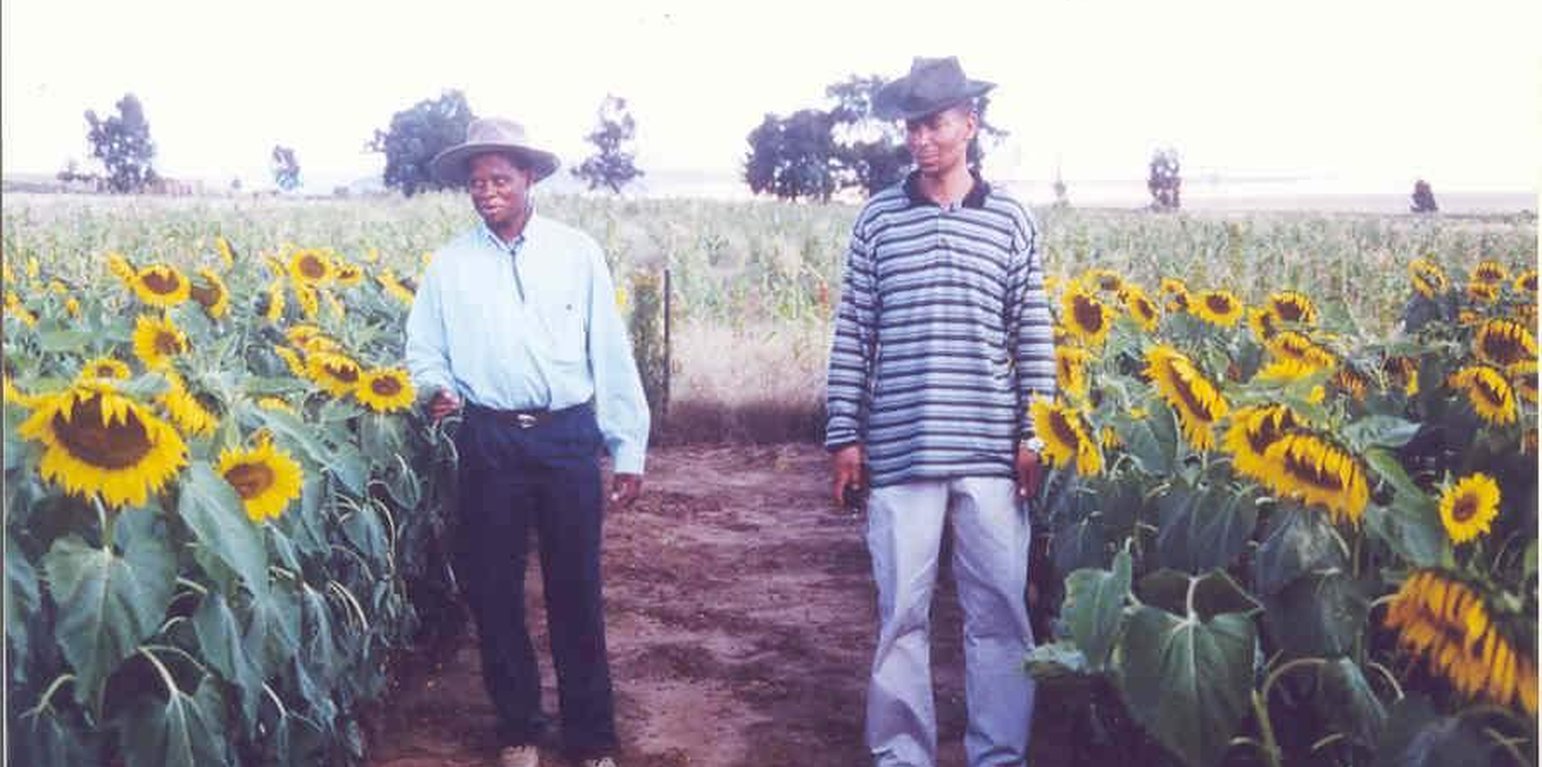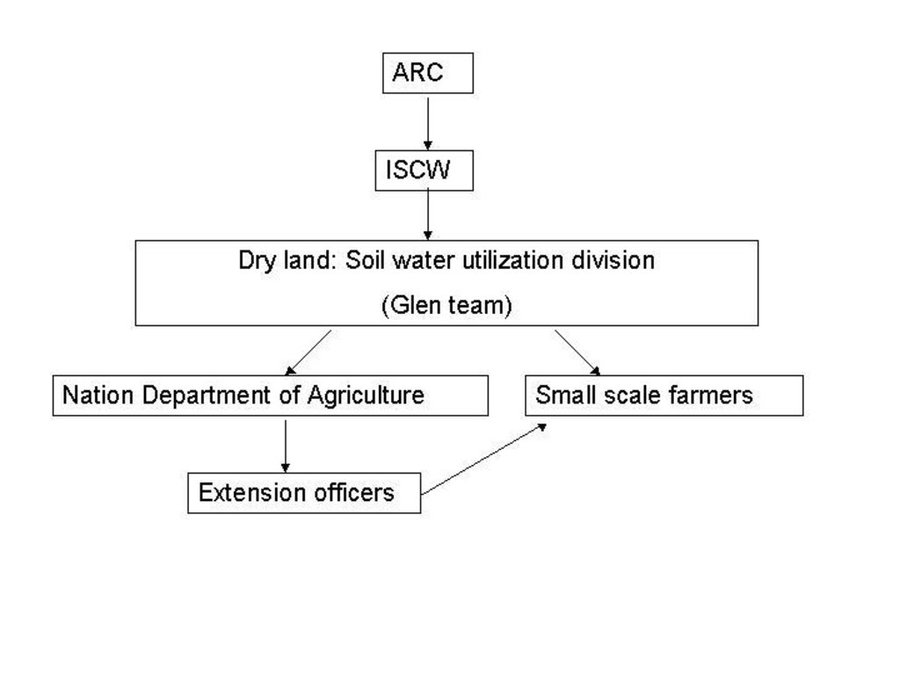Water Harvesting & Basin tillage (WHB) through demonstrations
(جنوب أفريقيا)
الوصف
Optimising rainwater use, reduce runoff by use of basins and reduce evaporation losses by applying a mulch (stone/reeds) on the runoff strip and in the basins.
Aims / objectives: Given the marginal soils of a clayey nature and/or slope terrain, coupled with erratic rainfall events, the technology aims to harvest available rain water and prevent runoff and soil loss. At present, PRAs are conducted in target areas and so far, people are eager to adopt the technology. The aim is to train them and assist in constructing the basins so that after a year they will be able to take over the project entirely even though the team will still be around to provide advice should the need arise.
الموقع
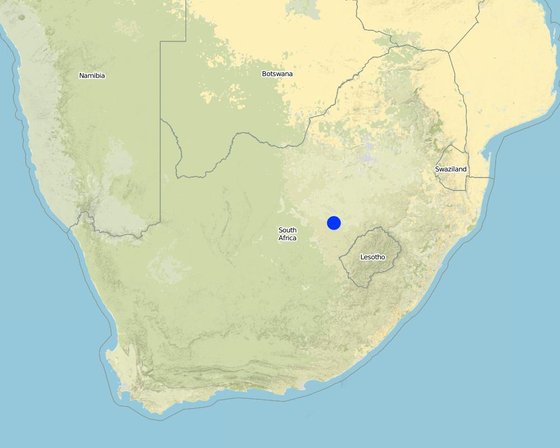
الموقع: Free State, جنوب أفريقيا
المرجع الجغرافي للمواقع المختارة
تاريخ البدء: 1996
سنة الإنهاء: 2002
نوع النهج
-
تقليدي/أصلي
-
مبادرة محلية حديثة/مبتكرة
-
قائم على مشروع/برنامج
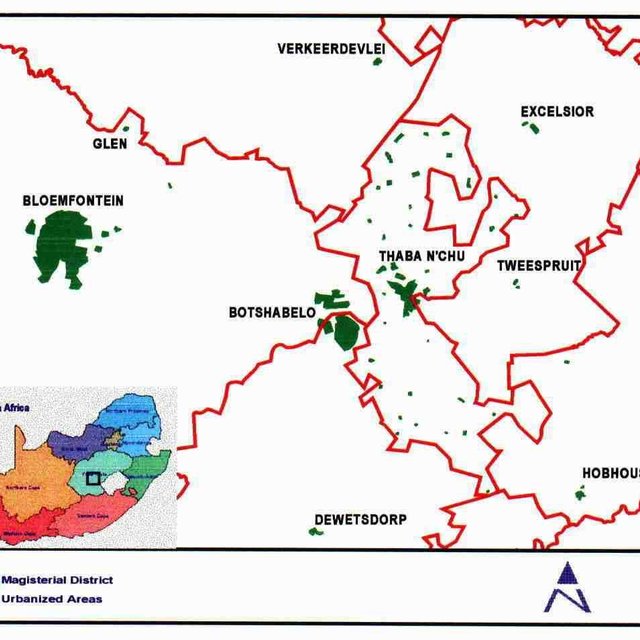
Map
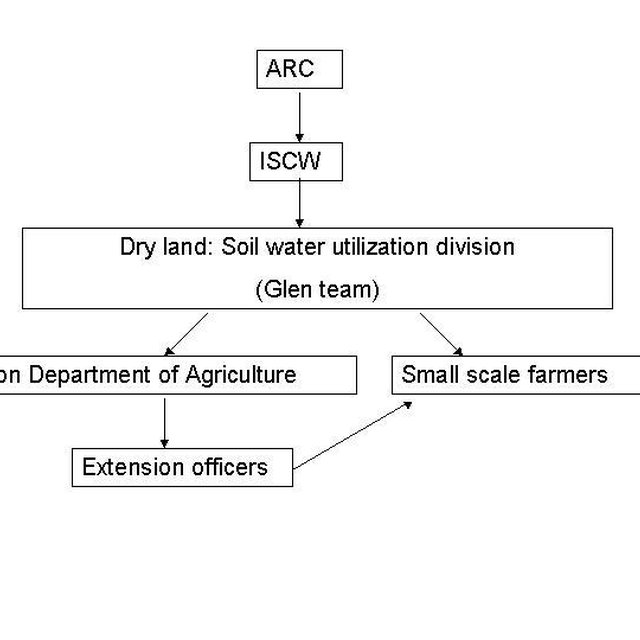
Organogram
غايات النهج والبيئة المواتية
الغايات/الأهداف الرئيسية للنهج
The Approach focused on SLM only (n/a)
*To make optimal use of pre-plant water that collects in basins from summer rains that fall during the fallow period. Saved water very beneficial during the reproductive growth of plants which often occurs when there is no rain.
*Prevention of soil and water loss through water erosion and runoff by the use of basins.
*Restriction of evaporation by the use of mulch. Straw is mostly preferred for its biodegradability although stone in comparative percentage cover is more effective.
The SLM Approach addressed the following problems: The target areas are marginal for crop production because of relatively low and erratic rainfall and dominantly clay soils on which the precipitation use efficiency is low because of high losses due to runoff and evaporation form the soul surface.
الشروط التي تمكن من تنفيذ التقنية/التقنيات المطبقة في إطار النهج
-
الإطار القانوني (حيازة الأراضي، وحقوق استخدام الأراضي والمياه): The existing land ownership, land use rights / water rights greatly helped the approach implementation: Land owners have little deeds and no law inhibits them from actively participating in the project.
الظروف التي تعيق تنفيذ التقنية/التقنيات المطبقة في إطار النهج
-
المعايير والقيم الاجتماعية /الثقافية/ الدينية: People are resistant to change. Had to convince that they can get better yields with new technique.
Treatment through the SLM Approach: Interacting with people as much as possible and comparing yields on farmers days after harvest.
-
توفر/الوصول إلى الموارد والخدمات المالية: Most can't afford inputs and to hire labour for construction of basins.
Treatment through the SLM Approach: Team will ask for discounts from providers and encourage team work amongst community.
مشاركة وأدوار الأطراف المعنية
الأطراف المعنية بالنهج وأدوارها
| ما هي الجهات المعنية / الكيانات المنفذة التي شاركت في النهج؟ |
حدد الأطراف المعنيين |
وصف أدوار الأطراف المعنية |
| مستخدمو الأراضي المحليون/المجتمعات المحلية |
Land owners and local chiefs. Approach can only be implemented with their acceptance and approval. Specific ethnic groups: Black, resource poor farmers |
Women tend to be submissive and docile. They look up to the men for decision making. |
| متخصصون في الإدارة المستدامة للأراضي / مستشارون زراعيون |
|
|
| الحكومة الوطنية (المخططون، صانعو القرار) |
|
|
| منظمة دولية |
ARC - ISCW |
|
انخراط مستخدمي الأراضي المحليين/المجتمعات المحلية في المراحل المختلفة للنهج
غير موجود
سلبي
الدعم الخارجي
تفاعلي
التعبئة الذاتية
المبادرة/التحفيز
rapid/participatory rural appraisal
Research
on-farm; On-station experiments are conducted at Glen to evaluate different SWC techniques. The new technology is transferred by means of on-farm demonstration plots and information days.
اتخاذ القرار بشأن اختيار تقنية الإدارة المستدامة للأراضي
وقد تم اتخاذ القرارات من قبل
-
مستخدمو الأراضي وحدهم (المبادرة الذاتية)
-
مستخدمو الأراضي بشكل أساسي، بدعم من متخصصي الإدارة المستدامة للأراضي
-
جميع الجهات الفاعلة ذات الصلة، كجزء من نهج تشاركي
-
متخصصون في الإدارة المستدامة للأراضي بشكل أساسي، بعد التشاور مع مستخدمي الأراضي
-
متخصصون في الإدارة المستدامة للأراضي بمفردهم
-
السياسيون / القادة
تم اتخاذ القرارات بناء على
-
تقييم المعرفة الموثقة جيدًا بشأن الإدارة المستدامة للأراضي(اتخاذ القرارات القائمة على الأدلة)
-
نتائج البحوث
-
خبرة وآراء شخصية(غير موثقة)
الدعم الفني وبناء القدرات وإدارة المعرفة
شكلت الأنشطة أو الخدمات التالية جزءًا من النهج
-
بناء القدرات/التدريب
-
خدمة استشارية
-
تعزيز المؤسسات (التطوير التنظيمي)
-
الرصد والتقييم
-
البحوث
بناء القدرات/التدريب
تم تقديم التدريب للأطراف المعنية التالية
-
مستخدمو الأراضي
-
موظفون ميدانيون/ مستشارون
-
extensionists/trainers
شكل التدريب
-
في العمل
-
من مزارع إلى مزارع
-
مناطق العرض
-
اجتماعات عامة
-
دورات
المواضيع المغطاة
Construction of basins; better understanding of the system in simple terms; the concept of infiltration, evapotranspiration; erosion and runoff.
خدمة استشارية
تم تقديم الخدمة الاستشارية
-
في حقول مستخدمي الأراضي
-
في مراكز دائمة
NDA Extension; Key elements: Assistance in technology transfer, Organising public meetings, Establishing & link between specialists and land users;
1) Advisory service was carried out through: government's existing extension system. Extension staff: mainly government employees
2) Target groups for extension: land users; Activities: Technology transfer
Advisory service is quite adequate to ensure the continuation of land conservation activities; With a little persuasion, they assist completely.
تعزيز المؤسسات
تم تعزيز/إنشاء المؤسسات
-
لا
-
نعم، قليلا
-
نعم، باعتدال
-
نعم، إلى حد كبير
صف المؤسسة والأدوار والمسؤوليات والأعضاء وما إلى ذلك.
نوع الدعم
-
مالي
-
بناء القدرات/التدريب
-
معدات
مزيد من التفاصيل
الرصد والتقييم
bio-physical aspects were regular monitored through measurements
socio-cultural aspects were None monitored through measurements
economic / production aspects were None monitored through measurements
There were few changes in the Approach as a result of monitoring and evaluation: An organic mulch can be placed in the basins and on the runoff strip to stop evaporation losses. However cattle are allowed to graze in the land after the crop has been harvested. There after there is almost no organic mulch left to cover the soil surface. Stones were then suggested as an alternative mulch.
البحوث
تناول البحث المواضيع التالية
-
علم الاجتماع
-
الاقتصاد / التسويق
-
علم الايكولوجيا
-
تكنولوجيا
Research was carried out both on station and on-farm
التمويل والدعم المادي الخارجي
الميزانية السنوية بالدولار الأمريكي لمكون الإدارة المستدامة للأراضي
-
< 2000
-
10,0000-2,000
-
100,000-10,000
-
1,000000-100،000
-
> 1,000,000
Precise annual budget: غير متاح
Approach costs were met by the following donors: national non-government (Water Research Commission): 100.0%
تم تقديم الخدمات أو الحوافز التالية لمستخدمي الأراضي
-
الدعم المالي/المادي المقدم لمستخدمي الأراضي
-
إعانات لمدخلات محددة
-
الائتمان
-
حوافز أو وسائل أخرى
الدعم المالي/المادي المقدم لمستخدمي الأراضي
العمل من قبل مستخدمي الأراضي كان
-
تطوعي
-
الغذاء مقابل العمل
-
مدفوع نقدا
-
مقابل دعم مادي آخر
تحليل الأثر والتصريحات الختامية
آثار النهج
لا
نعم، قليلا
نعم، باعتدال
نعم، إلى حد كبير
هل ساعد النهج مستخدمي الأراضي على تنفيذ وصيانة تقنيات الإدارة المستدامة للأراضي؟
Did other land users / projects adopt the Approach?
Team about to start a food security project adopting the WHB.
المحفز الرئيسي لقيام مستخدمي الأراضي بتنفيذ الإدارة المستدامة للأراضي
استدامة أنشطة النهج
هل يمكن لمستخدمي الأراضي الحفاظ على استدامة ما تم تنفيذه من خلال النهج (بدون دعم خارجي)؟
الاستنتاجات والدروس المستفادة
نقاط القوة: وجهة نظر مستخدم الأرض
نقاط القوة: وجهة نظر جامع المعلومات أو غيره من الأشخاص الرئيسيين لمصدر المعلومات
-
Success of the WHB technique depends on suppressing water losses by runoff (R) and evaporation from the soil surface (Es). Measurements show that R has been reduced to zero and that Es has been reduced considerable, but still remains a serious avenue for water loss. (How to sustain/ enhance this strength: Future experimentation needs to focus on suppressing Es by any possible means.)
-
The WHB treatment gives considerably better yields than the conventional treatment. (How to sustain/ enhance this strength: Results from more seasons are needed to quantify the extent of this difference in a reliable way.)
-
Save on cultivation costs since no-till is employed.
-
The WHB technique is ell suited for use on very small pots, and even in townships. Many people in semi-arid areas could be usefully employed if this technique was widely adapted, and food security could be increased at the same time. (How to sustain/ enhance this strength: Extension work in this connection by the PSDA needs to be encourage.)
-
Soil loss from the land as a whole is zero. This is an important advantage over the conventional tillage in terms of sustainability.
نقاط الضعف / المساوىء / المخاطر: وجهة نظر مستخدم الأرضكيفية التغلب عليها
-
It is labour intensive to initially construct the basins, by hand.
نقاط الضعف / المساوىء / المخاطر: وجهة نظر جامع المعلومات أو غيره من الأشخاص الرئيسيين لمصدر المعلوماتكيفية التغلب عليها
-
There is some soil movement form the runoff area into the basins, ad basins may silt up over time.
-
Huge storms may overflow and break basin walls; and basins may need some maintenance.
-
In the case of small rainfall events all the water may not reach the basins.
-
Organic mulch may act as a sponge and absorb some of the rainwater.
المراجع
تاريخ التوثيق: 13 يناير، 2009
اخر تحديث: 11 يوليو، 2017
الأشخاص الرئيسيين لمصدر المعلومات
-
Cobus Botha (botha@glen.agric.za) - متخصص في الإدارة المستدامة للأراضي
الوصف الكامل في قاعدة بيانات WOCAT
بيانات الإدارة المستدامة للأراضي المرتبطة
تم تسهيل التوثيق من قِبَل
المراجع الرئيسية
-
Optimising rainfall use efficiency for developing farmers with limited access to irrigation water, WRC Report No 878/1/00. Hensley, M; Botha, JJ; Anderson, JJ; Van Staden, PP & Du Toit, A. 2000Video 'In field Rainwater harvesting (1) Basic concepts to ensure agronomic and conservation sustainability in small scale farming'.The video illustrates the existing results obtained to enhance agronomic and conservation sustainability.: R120. Leon van Rensburg, P/B X01, Glen, 9360. Debruint@glen.agric.za
-
Optimising rainfall use efficiency for developing farmers with limited access to irrigation water, WRC Report No 878/1/00. Hensley, M; Botha, JJ; Anderson, JJ; Van Staden, PP & Du Toit, A. 2000:
-
Video 'In field Rainwater harvesting (1) Basic concepts to ensure agronomic and conservation sustainability in small scale farming'.:
